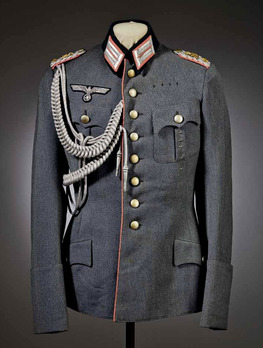German Army Armoured Officer's Old Style Dress Tunic
CATEGORY: Version
SKU: 20.GOR.02.01.01.03.02.004.000
Estimated market value:

Estimated market value:
Field-grey cloth with pink piping and stitched insignia. Shoulder boards of a colonel with number 31 on them. Complete with parade aiguilette. Tailor's label of company Traugott Rahne, Hanover. Interior pocket with wearer's label "Rittmeister v. Bodenhausen 30. 4. 1936". Stitched breast eagle.
The Old Style Service Tunic was designed in the style of its predecessor, the Reichswehr tunic. Later, it was supposed to be replaced by the Field Tunic and Dress Tunic, yet it proved so popular, especially with higher ranks, that it’s wearing out period was extended several times. In fact, it was worn well into the war.
It is field-grey and has either six or eight buttons down the front. The fall-down collar mostly came in field-grey as well, but there are also examples in dark blue-green. On the inside of the collar there are five buttons to attach the neck band. The tunic has two buttoned patch breast pockets with three point flaps. There are two slash pockets on the hips with buttoned slanted pocket flap. On top of that, there is a left side inside pocket. The turn-up cuffs are of the “French” style. The tunic has no tail pocket flaps, but there are two buttons at the back. All buttons are field-grey pebbled buttons.
Compared to NCOs (non-commissioned officers) and EMs (enlisted men), officers wore a tunic made of superior material quality. Their tunics had eight buttons down the front instead of six, and sometimes it came with patch hip pockets.
General ranks wore a tunic with gilt buttons and gilt national emblem. The tunic also features bright red piping down the edge of the front.
Officers wore a special dress tunic that was piped down the front like the General’s tunic, except the piping was in the wearer’s branch colour. NCOs and EMs were also allowed to privately purchase dress tunics with piping, however it is unknown to what extent this was done.
The tunic also came in the form of a denim tunic made from light drill material. It was mainly used for wear during the summer by the lower ranks. It differs from the regular tunic in that it has no lining or cuffs.

Comments
Sign in to comment and reply.


Scroll Top